Time control
GPS tracking data is focused on timestamps that are enriched with location data, accelleration data or spatial orientation data. Thus, the central unit common to all Firetail data is a timestamp, a measurement.
Note that acceleration data does not necessarily align to GPS data directly, for it commonly may often not exist for every GPS sample. Instead, this kind of data is often transmitted from the tags (sender units) as bursts starting at a defined timestamp.
Firetail has two basic concepts to work with visualize time:
- the selected timestamp
- the restricted time window
current time stamp
Whenever you load data into firetail, the complete dataset will be shown by
default. Each entity (acceleration data, GPS data) will be separately visible
in the Open Files Panel (see Open Files).
All selected entities are shown in the map.
You may the use the time control panel

to set the current timestamp by shifting the slider. The currently selected timestamp is shown as current time.
The earliest available timestamp in the data is shown under Start Time.
The latest available timestamp in the data isn shown under End Time.
Hint: fine-grained selections are possible via arrow left and arrow right.
The map will highlight the coordinates associated to this timestamp for all selected individuals/tags.
Selecting a timestamp from the map
In order to see when a given GPS coordinate was sent, you can double-click on a GPS trajectory drawn in the map view. The nearest timestamp will become

focusing on a time window – bracketing
When working with time series data that was captured over long periods of time it may become increasingly difficult to observe regions of interest. Firetail borrows a simple concept from video editing: bracketing.
You may define two timestamps (start and end) that define a time interval (window) that you want to restrict to.
- use the slider to select a start timestamp
- press
|<-to fix this timestamp as your interval start (bracket open) - use the slider to select a stop timestamp
- press
->|to fix this timestamp as your interval end (bracket close) - reset the bracketing using
R

The restricted interval can be restricted further and more fine-grained analysis can be performed and more precise selections are possible.
replay speed
To get an impression of behaviour or trends it is necessary to visualize
the GPS position as a function of time. By default, firetail will replay
all the timestamps in realtime when you hit the Play button (and thereby
update the currently selected time).
By selecting a replay speed you may speed up the replay or even observe the captured data in slow motion. There are two ways to define the speedup:
- define
1 second is n seconds(n is the interval of timestamps visualized in one second) - define
k seconds duration(k seconds to play the complete active interval)
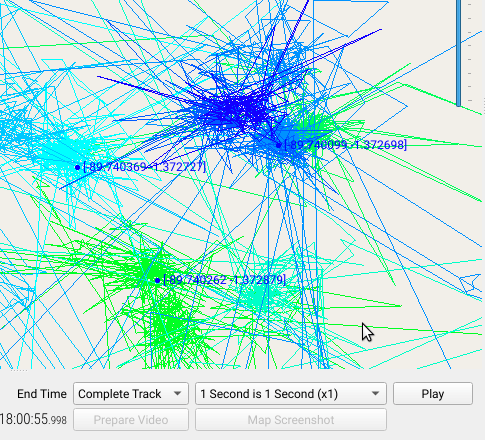
interval visualisation
It is often useful to not only precisely select intervals via bracketing, but also restrict the visualized data to a user selected time period, e.g. to avoid a cluttered viewport.
The interval restriction dropdown menu provides you with a selection of time ranges to decide
which range of data should be visible:
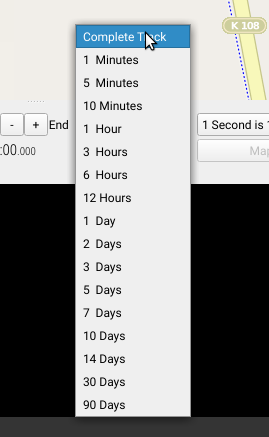
In this way, you can view past (given the selected timestamp) and future behavior:
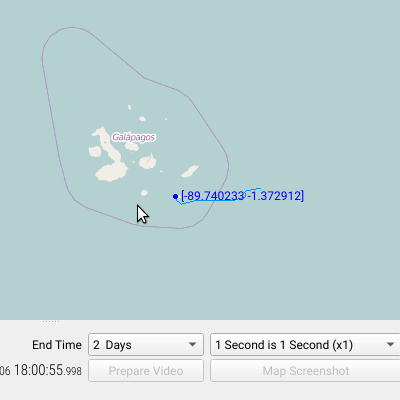
Note that we can now focus on specific regions of interest and also observe whether trajectories have met during this interval.
effective drill-down: step-wise interval restriction
When coping with huge amounts of data effective techniques to drill down to regions of interest becomes more essential. For example, annotations require fast visual inspection and precise interval selections.
Firetail provides controls for the restriction to and shifting of intervals of predefined length:
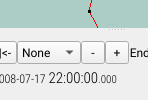
- Select a timestamp that roughly resembles area you wish to analyse using the time slider or map selection.
- Use the drop down menu for interval restriction to select a granularity: ‘hour’, ‘day’, ‘week’ or ‘month’. The closest enclosing interval will be selected e.g. 4-5am given ‘hour/4:33:00’ is selected
- Use ‘+’ and ‘-’ to step forward/backward to the next/previous interval. Start and end are updated accordingly.
Hint: Use the interval restriction to roughly select an interval of interest, then use manual bracketing to further refine to refine the selection.
A sample drill-down down:
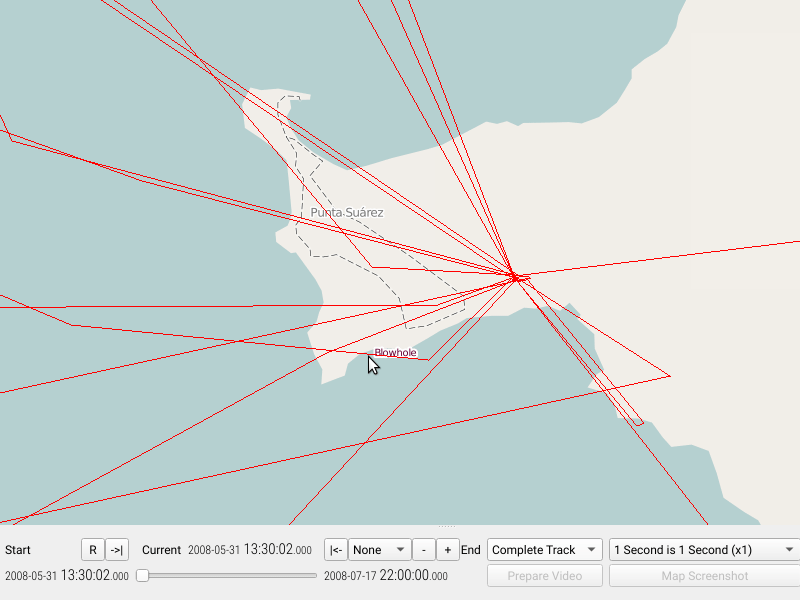
Sample video: interval restriction (mp4)
- A timestamp is selected roughly on the month level
- The interval restriction (jump width) is used to select ‘day’ granularity
- The interval restriction is used to select the correct hour
- The viewport is limited to cut the interval to the nearest hour